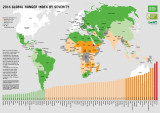Indice Globale della Fame 2014: la sfida della fame nascosta
A un anno dalla scadenza per il raggiungimento degli Obiettivi di Sviluppo del Millennio, fissata nel 2015, l’Indice Globale della Fame 2014 offre una prospettiva articolata del problema della fame nel mondo, che porta nuovi spunti al dibattito mondiale rispetto a dove concentrare gli sforzi nella lotta contro la fame e la malnutrizione. Secondo il GHI 2014, lo stato della fame nei Paesi in via di sviluppo è complessivamente migliorato in confronto al 1990, con un calo del 39%.











